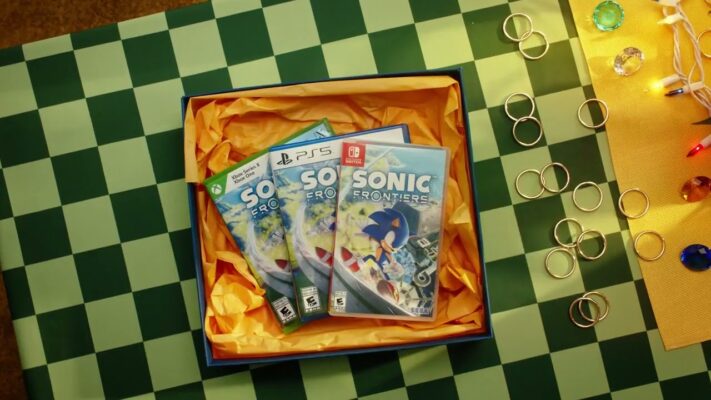On November 25, 2023, at Kyushu Sangyo University, a lecture titled “Efforts Toward Realizing Open Zones in Sonic Frontiers” was held at the developers’ conference “CEDEC+KYUSHU 2023”. Various initiatives, including solving turning problems, were discussed to enable Sonic to race through a vast world, and their secrets were revealed.
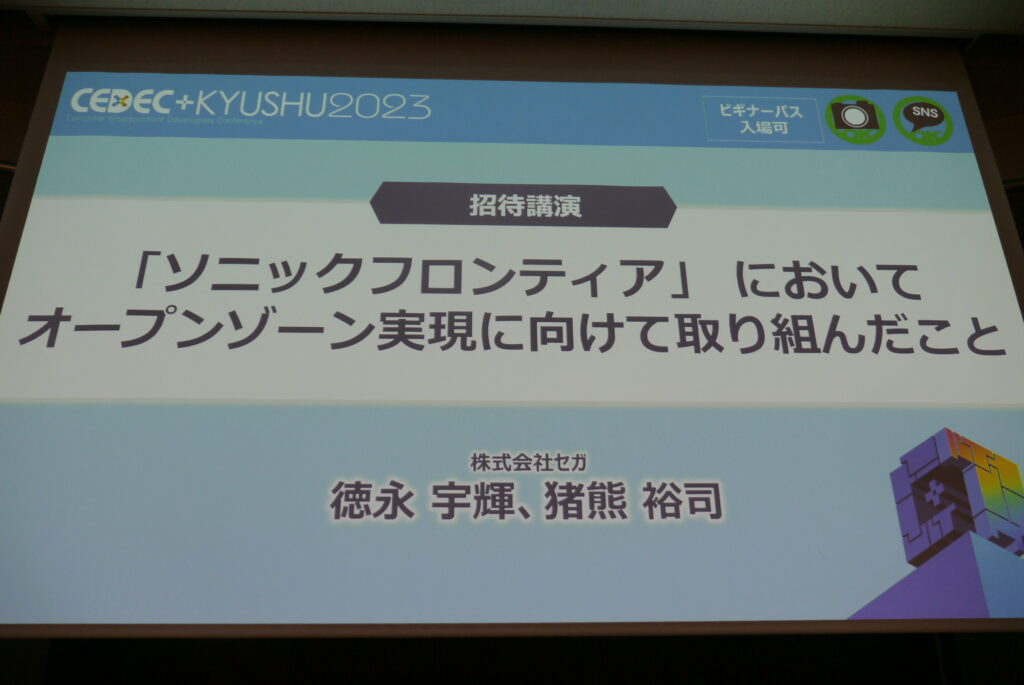
Making the Game Easier to Play While Maintaining the Speed Characteristic
The Sonic series is an action game known for its sensation of speed, featuring Sonic, the world’s fastest hedgehog, running at super high speeds. There are two pivotal points in the game system of the series.
One is the release of the 3D action game “Sonic Adventure” in 1998. The other is the challenge of “Open Zone” in “Sonic Frontiers” (PC / PS5 / Xbox Series X|S / Nintendo Switch / PS4 / Xbox One) in 2022. An Open Zone is a concept where players can freely roam a vast field while enjoying the core experience of 3D action gameplay. Mr. Hiroki Tokunaga, the lead programmer, and Mr. Hiroshi Inokuma, the lead graphics programmer, spoke about the efforts to realize the series’ first Open Zone.
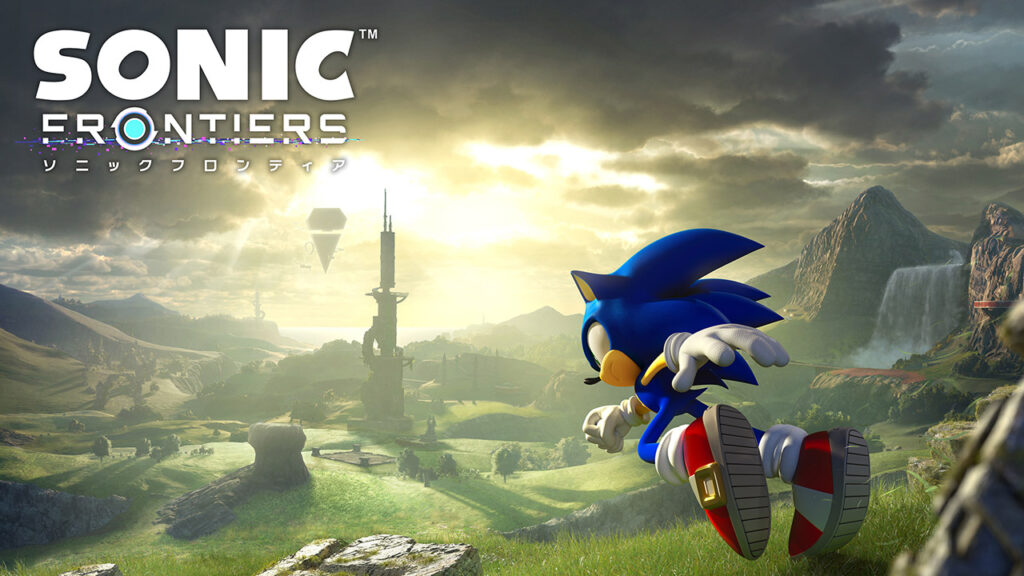
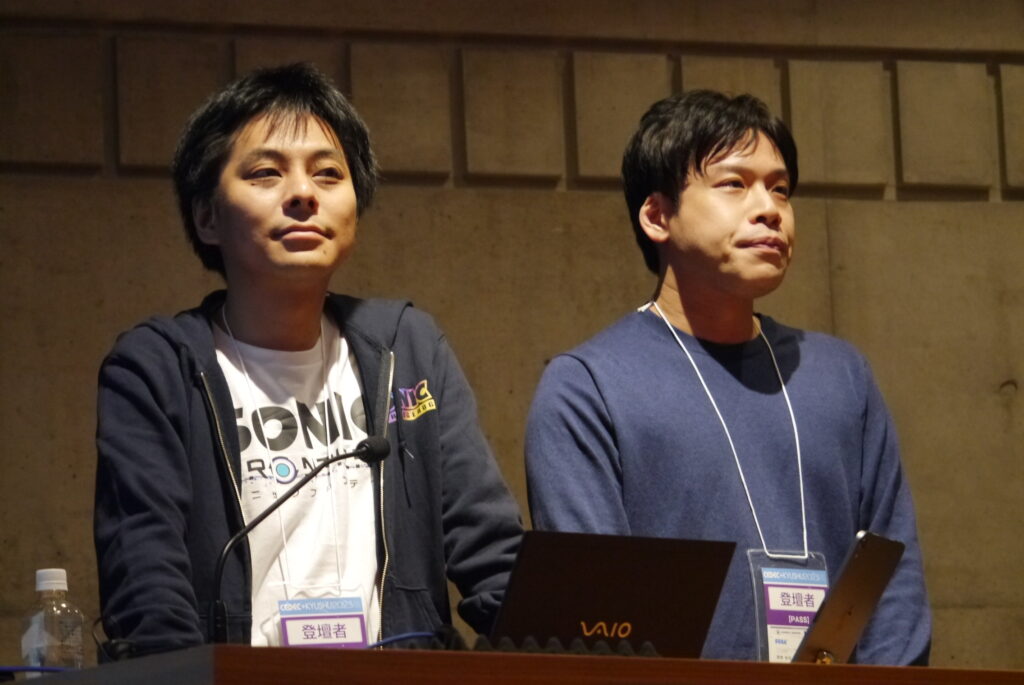
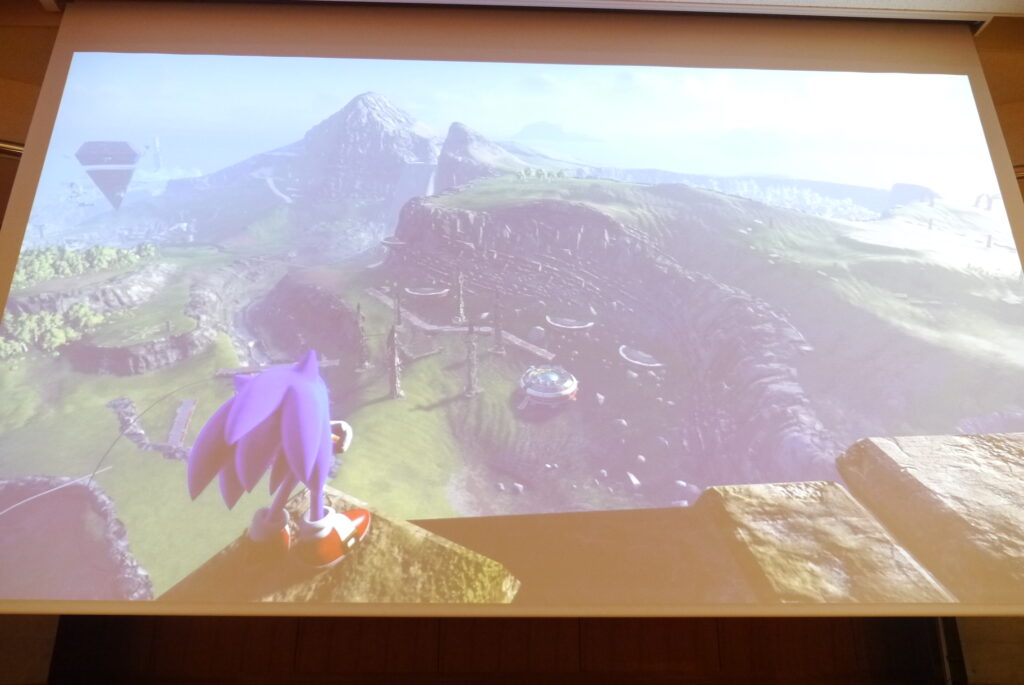
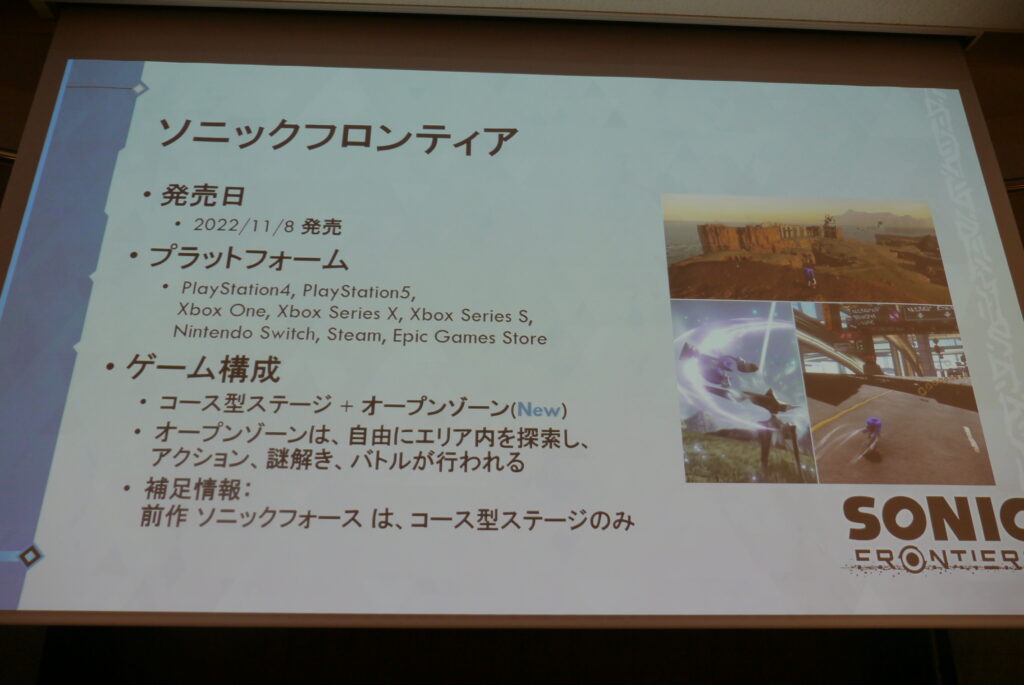
Sonic Frontiers has significant differences in game design from the recent Sonic Forces.
Sonic Forces:
- Essentially a single path with a total length of 1-5 km
- Course-type platform action
- Surrounding environment is fixed
Sonic Frontiers:
- Open Zones in a wide space, not a single path, with destinations scattered in space, and the field is 4 km x 4 km
- Platform action with puzzle-solving elements
- Surrounding environment changes with time and weather
For the development of Sonic Frontiers, which can be considered a different entity from previous works, new initiatives had to be undertaken.
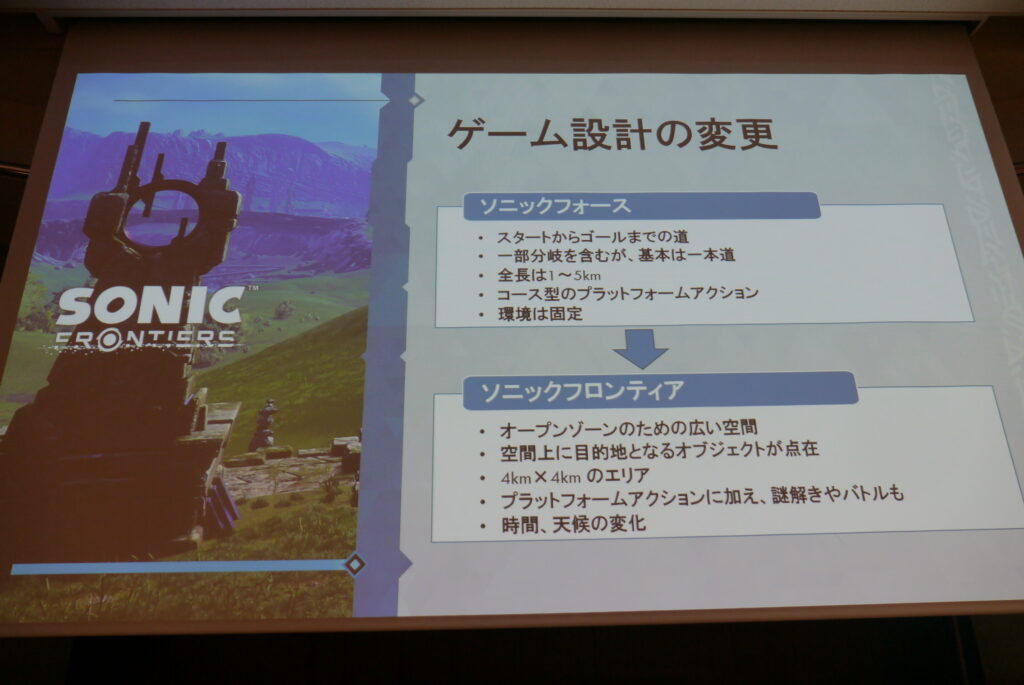
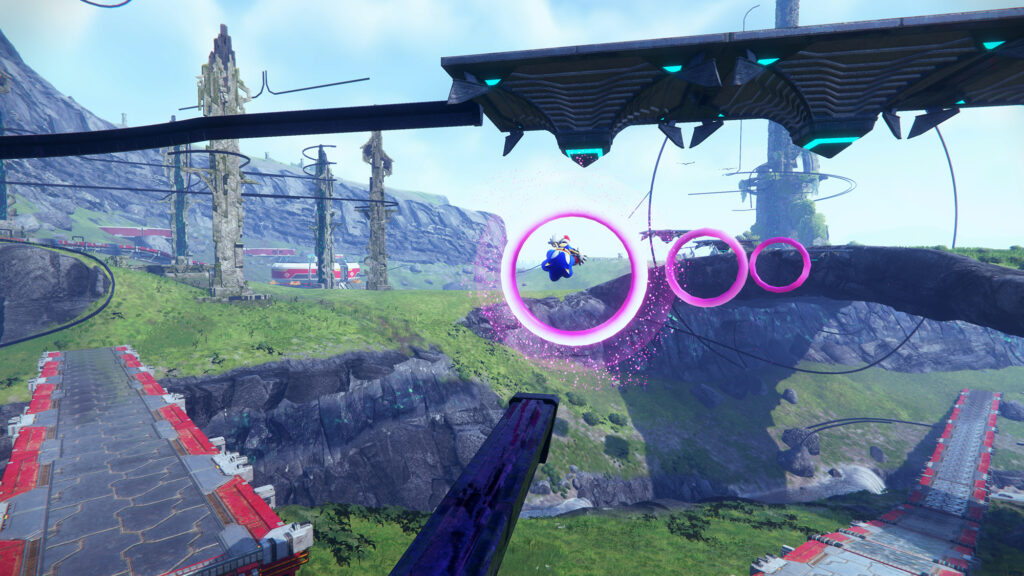
●Terrain Production
The terrain in Sonic Forces is a single path of 1-5 km, manually laid out by designers. However, the open field of Sonic Frontiers is 4 km x 4 km, much larger than Sonic Forces, and it was anticipated that the same manual work would be challenging to achieve.
In Sonic Frontiers, Height Field was added to the terrain collision, and the terrain is now represented by Height Map and Height Field, rather than manual placement. The Height Field consists of a 1 m x 1 m grid, and editing the Height Map will update the Height Field in real-time. Minor changes can be made while playing, and this methodological shift has made it possible to create vast spaces at a lower cost.
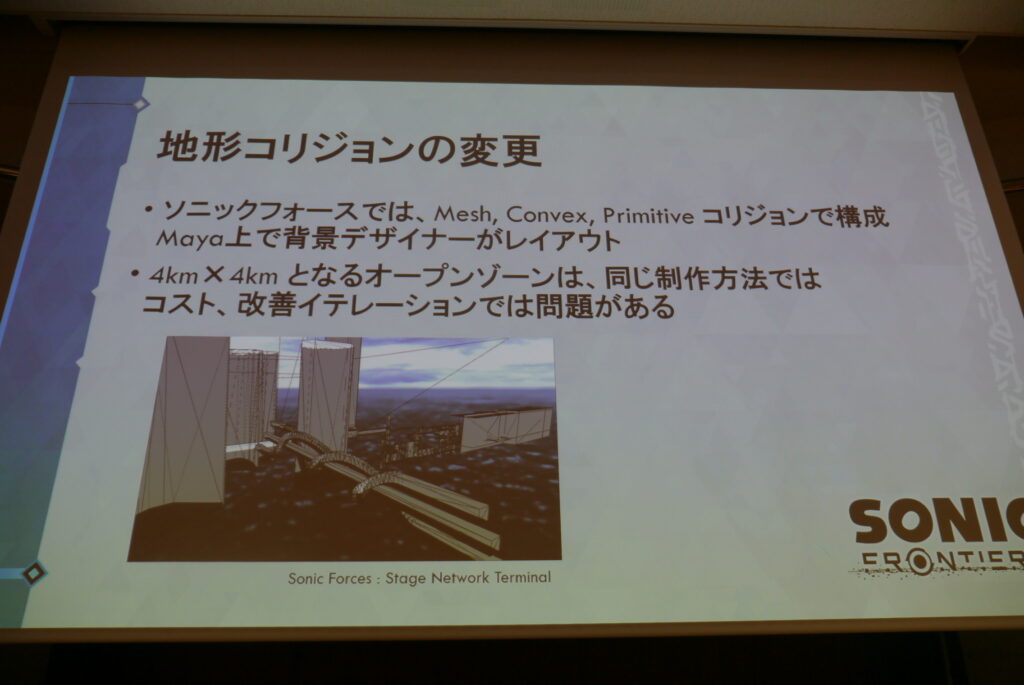
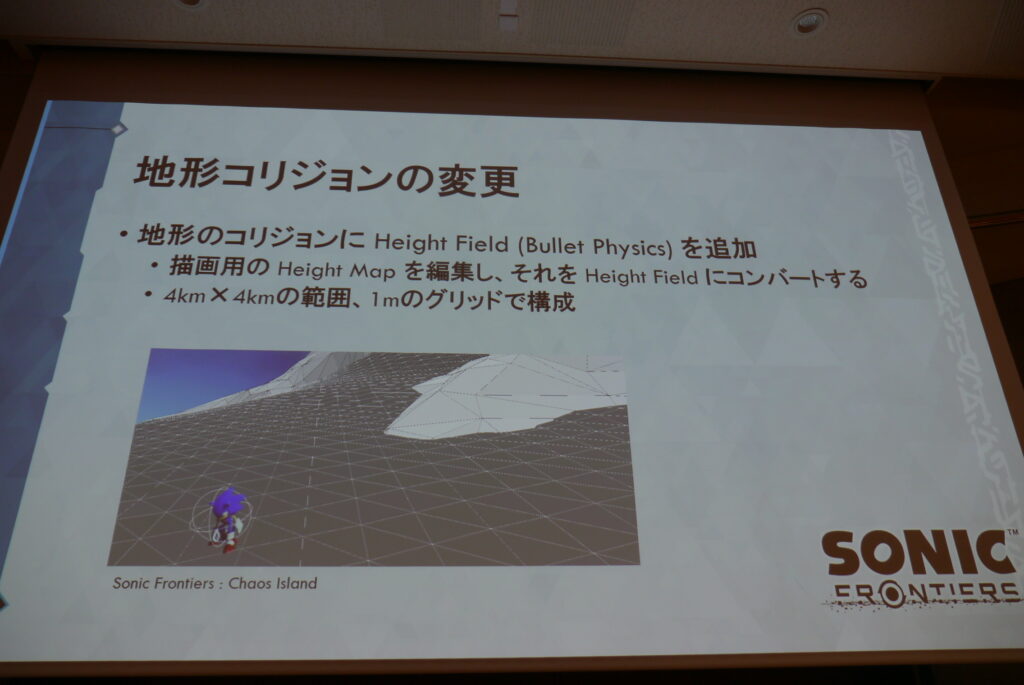
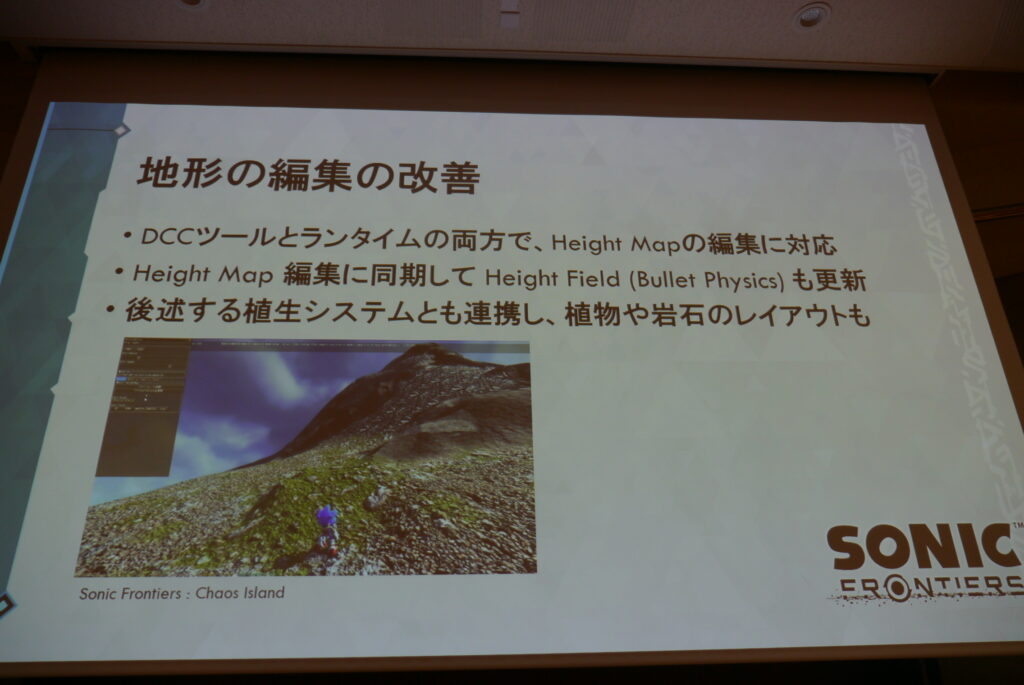
●Character Control
The transition from the course-type Sonic Forces to the Open Zone of Sonic Frontiers required changes to Sonic’s movements. In the single-path map of Sonic Forces, Sonic’s speed and turning power were kept constant, allowing for smooth turns. This was suitable for drawing beautiful curves and performing actions while running.
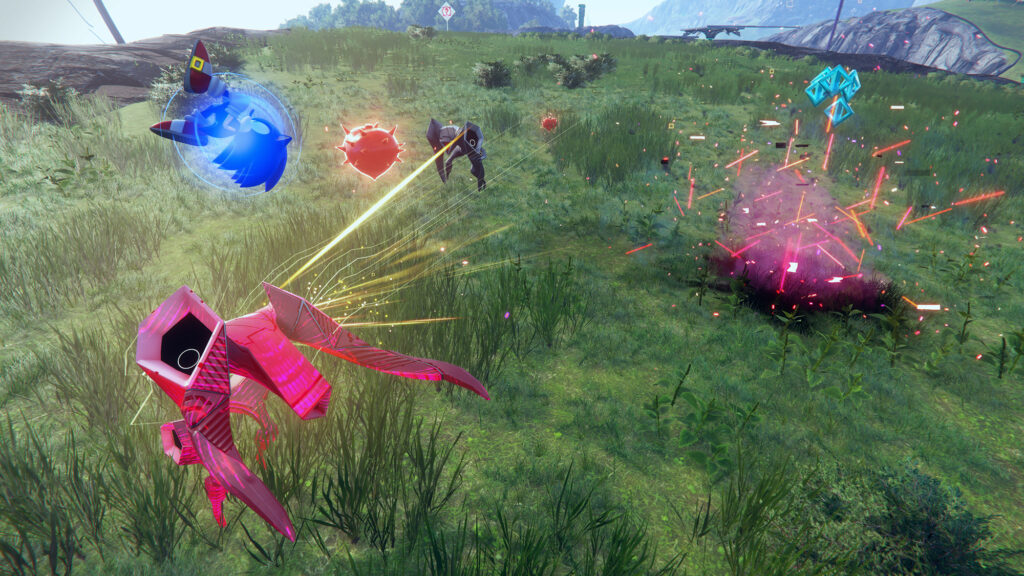
However, in the map of Sonic Frontiers, there are various targets scattered around. The gentle curves of Sonic Forces would not allow for timely turns after seeing a target, making it impossible to reach the destination. This was a “fatal problem” (Mr. Tokunaga) in realizing the Open Zone. Simply increasing the turning power to make quick turns (tight curves) would not solve the problem, as Sonic’s speed is too fast, leading to over-turning. Players would try to correct this by turning in the opposite direction, making control difficult. In short, Sonic was too fast to make tight turns.
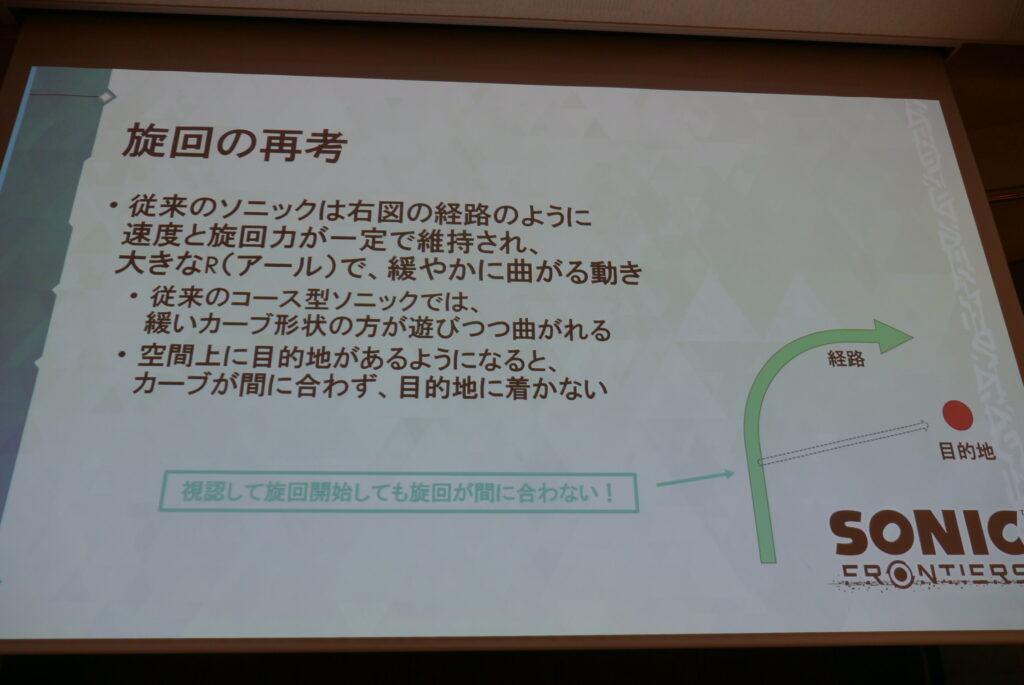
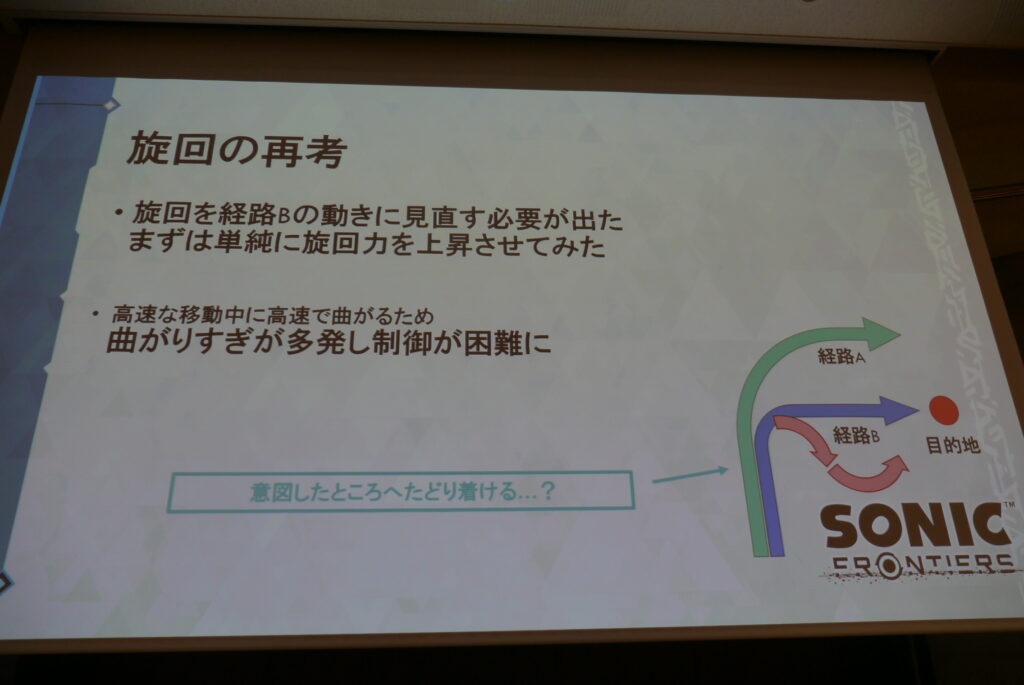
To summarize, during turns, there is a desire to decelerate, but maintain high speed for straight-line movement, and quickly turn in terms of trajectory. However, Sonic does not have an accelerator or brake. It became clear that if turning and speed automatically interacted, it would be beneficial.
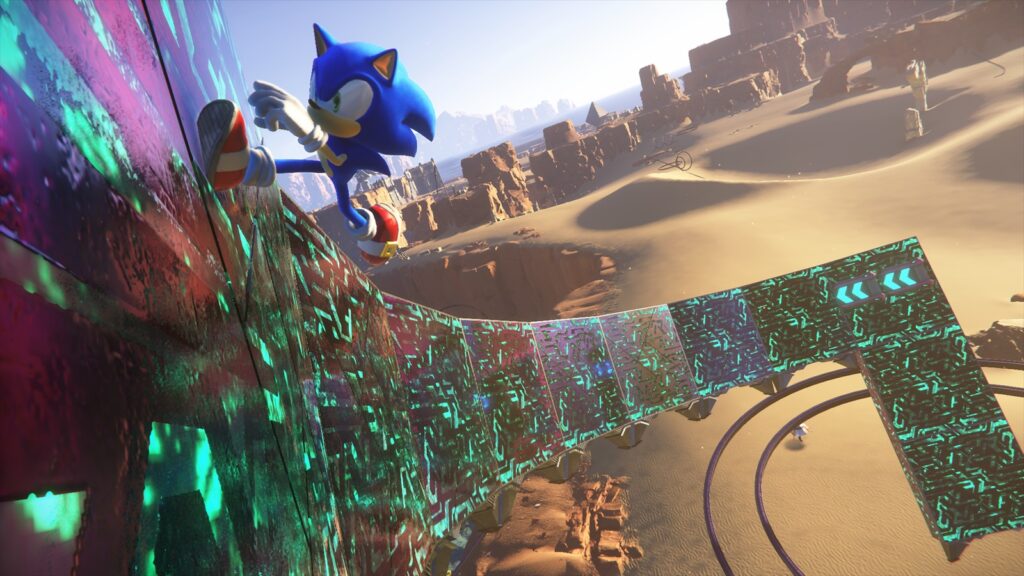
Thus, Sonic’s movement in Sonic Frontiers became deceleration during turns, increasing turning power with deceleration. The flow is “maintaining top speed for straight-line movement → automatic deceleration by turning operation → quick turning due to deceleration → re-acceleration when turning ends (turning direction and input direction match) → turning power decreases with acceleration.”
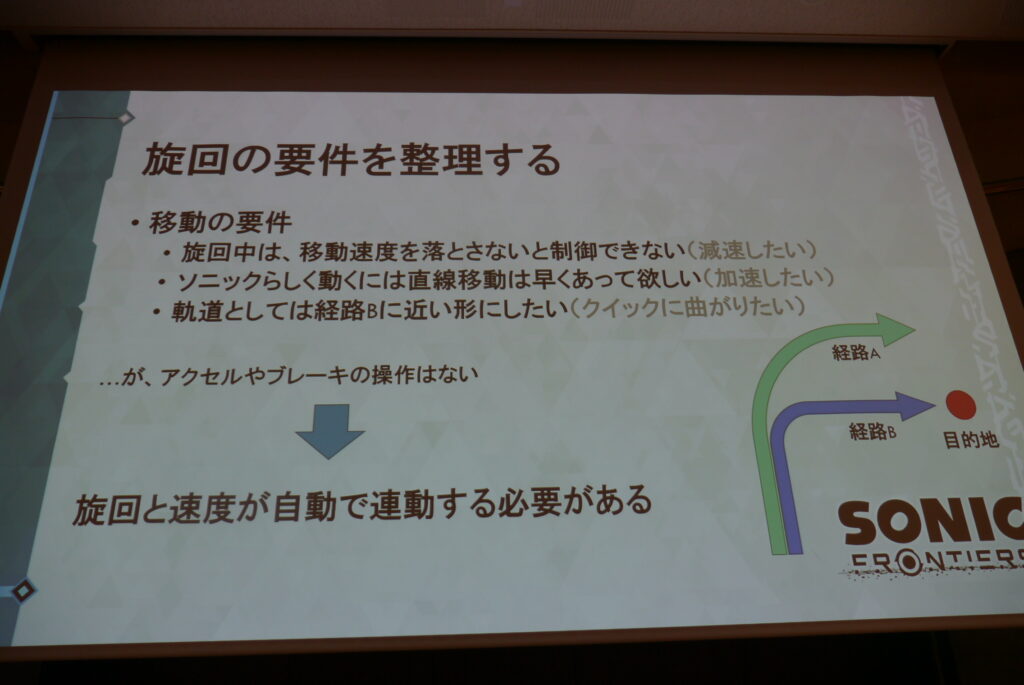
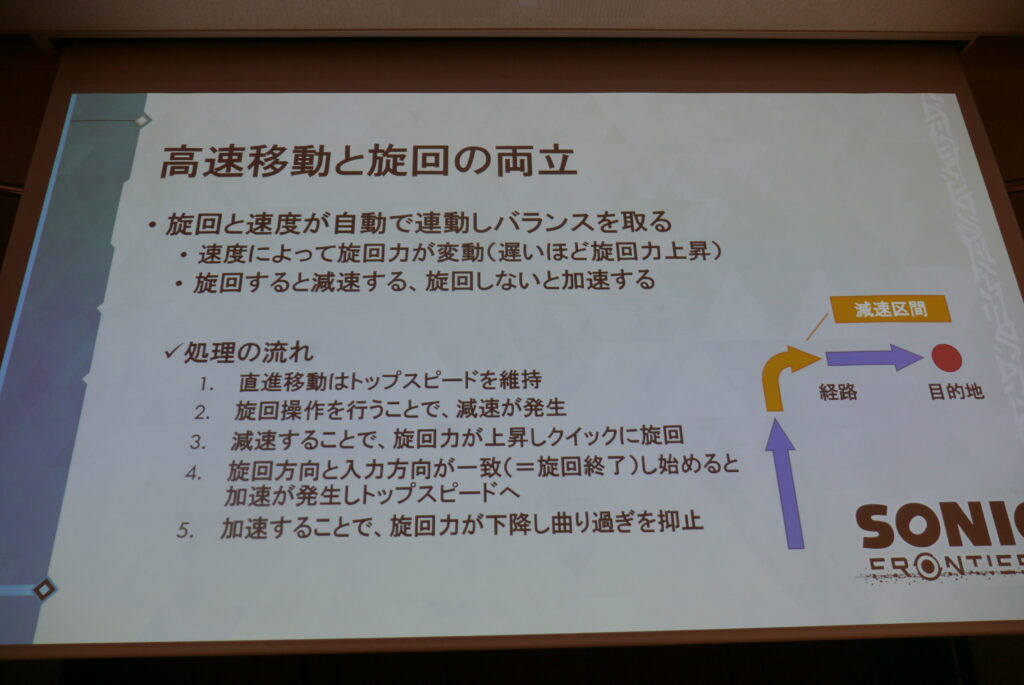
This improvement has also enhanced the operability of attacks. This is evident in the distinctive “Cyloop” of Sonic Frontiers. Sonic can damage enemies by encircling them with the path he runs, but before the improvement, if he slowed down to draw a circle, the enemy would move away, and if he tried to encircle quickly, he would overshoot. The current Cyloop allows for high-speed approach, automatic deceleration when encircling, and automatic acceleration to escape after completing the circle, achieving both operability and Sonic’s characteristics.
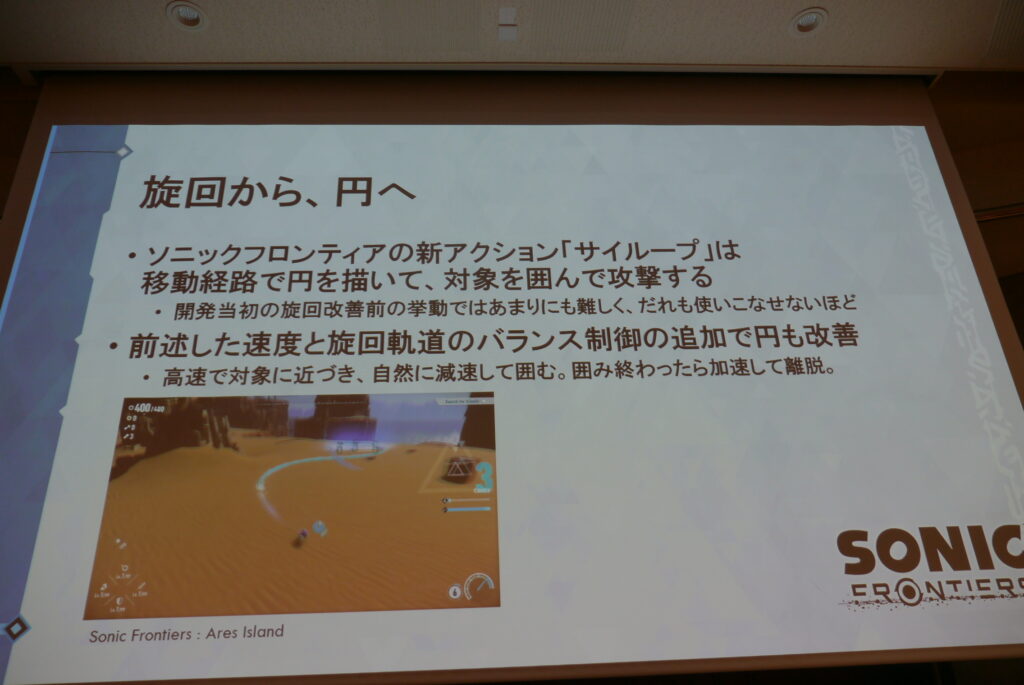
●Enemy Control
Enemy control also had to be developed to suit the Open Zone. Previous enemies had simple movements, such as staying in a specific position or moving back and forth on a predetermined route. This was partly because Sonic’s speed was too fast, and even if enemies had complex movements, players would pass by before understanding them. In a fixed single-path map, terrain detection is unnecessary, and processing can be lightweight.
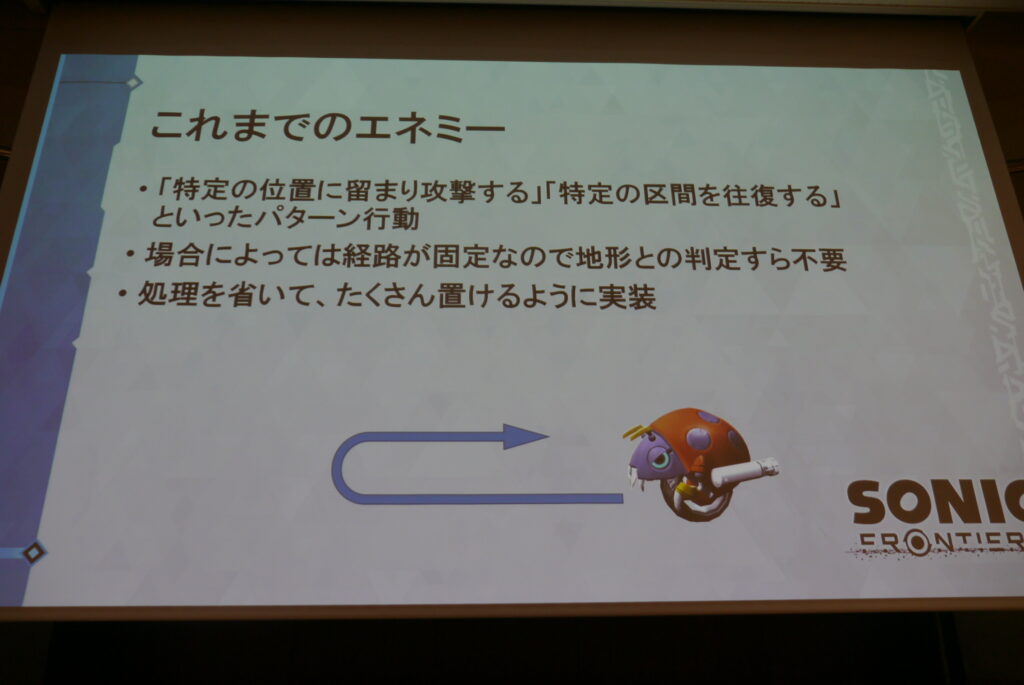
However, in the Open Zone, enemies are also expected to move freely. Therefore, Sonic Frontiers introduced NavMesh, used to automatically move characters. NavMesh is baked from the shape of the collision and includes ground attribute information, allowing for characteristics such as “this enemy does not enter water.”
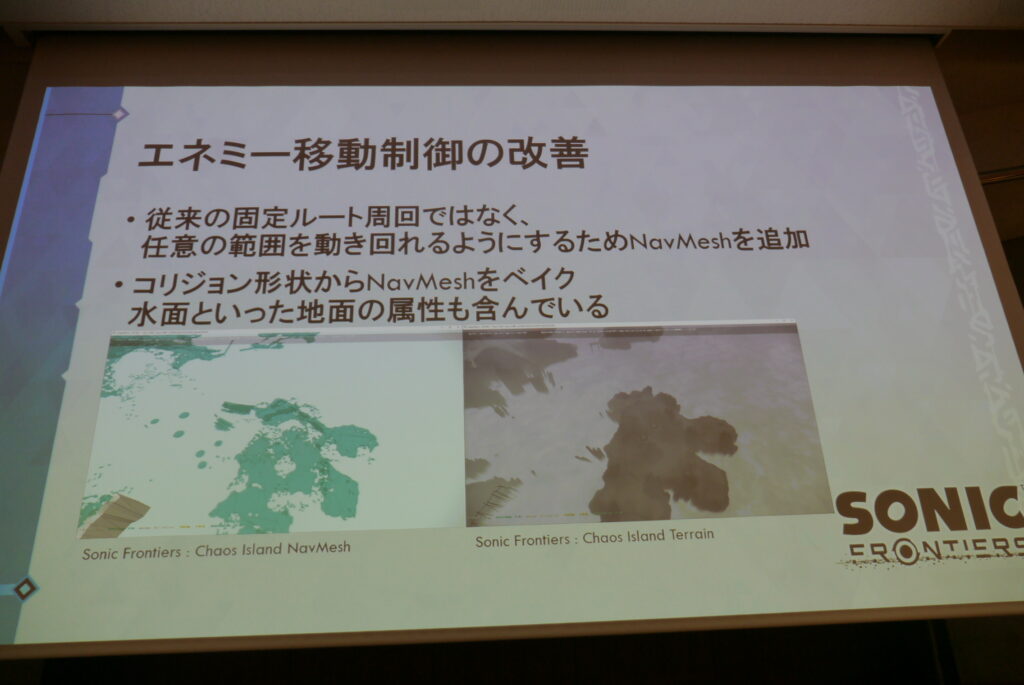
Nonetheless, the 4 km x 4 km Open Zone is vast. Placing enemies and objects in this area resulted in over 100,000 items, causing performance issues in low-spec environments. The development team added variations of High, Middle, and Low to the Character Controller and switched between them to reduce the load.
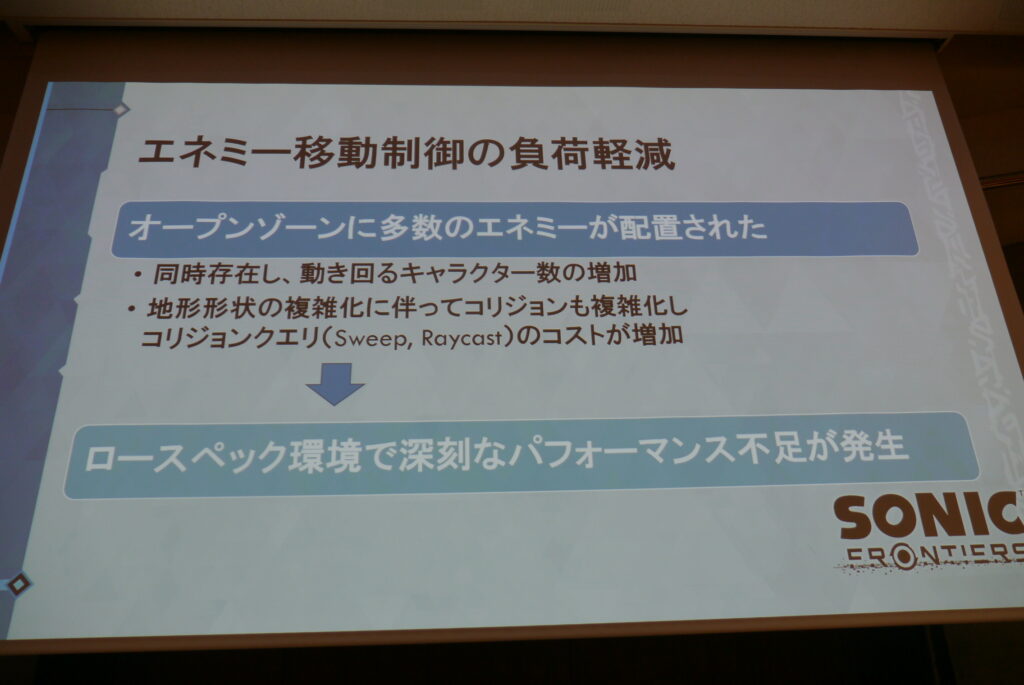
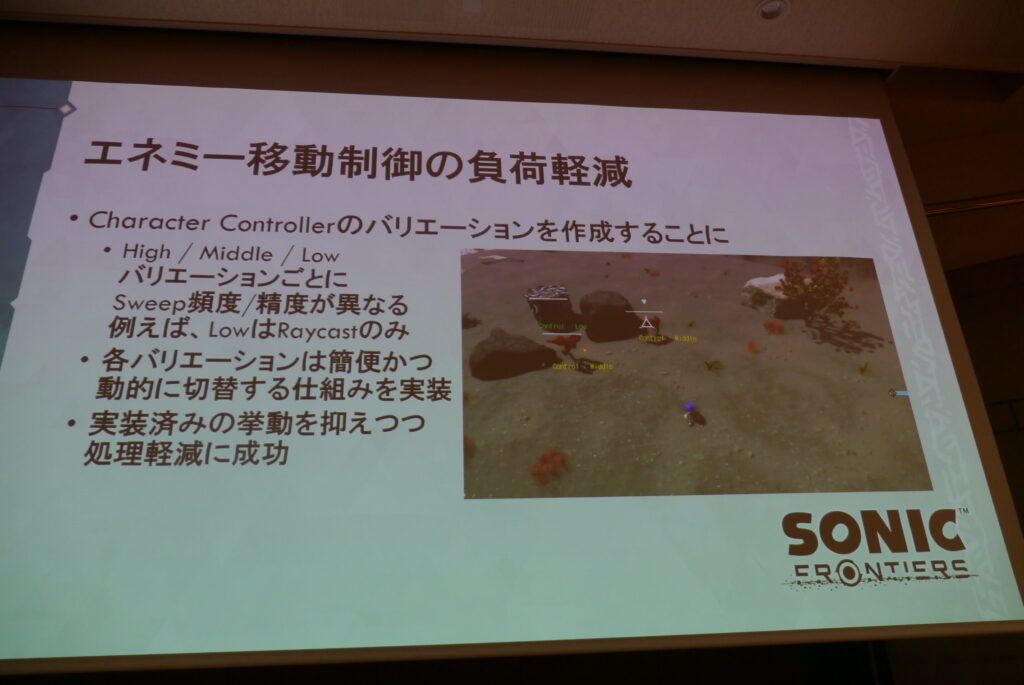
●Loading
For a series where high-speed movement is enjoyable, the goals were set to “not load during movement in the Open Zone” and “not interrupt with loading during fast travel.”
By keeping all models and collisions in memory and not performing stream loading, I/O was concentrated on textures. For textures, priority was given to not stopping game progress, loading high-resolution textures only for nearby objects, and reducing texture resolution in low-spec environments, achieving the aforementioned goals. Additionally, optimization of long loading times was performed, reducing a scene’s loading time from 25 seconds to 14 seconds.
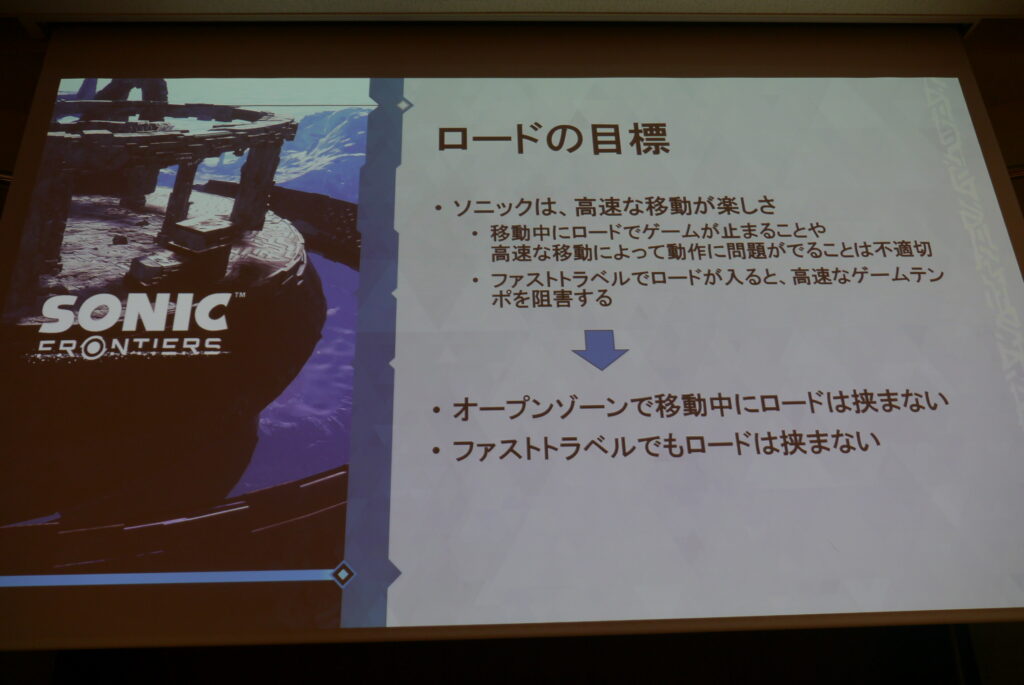
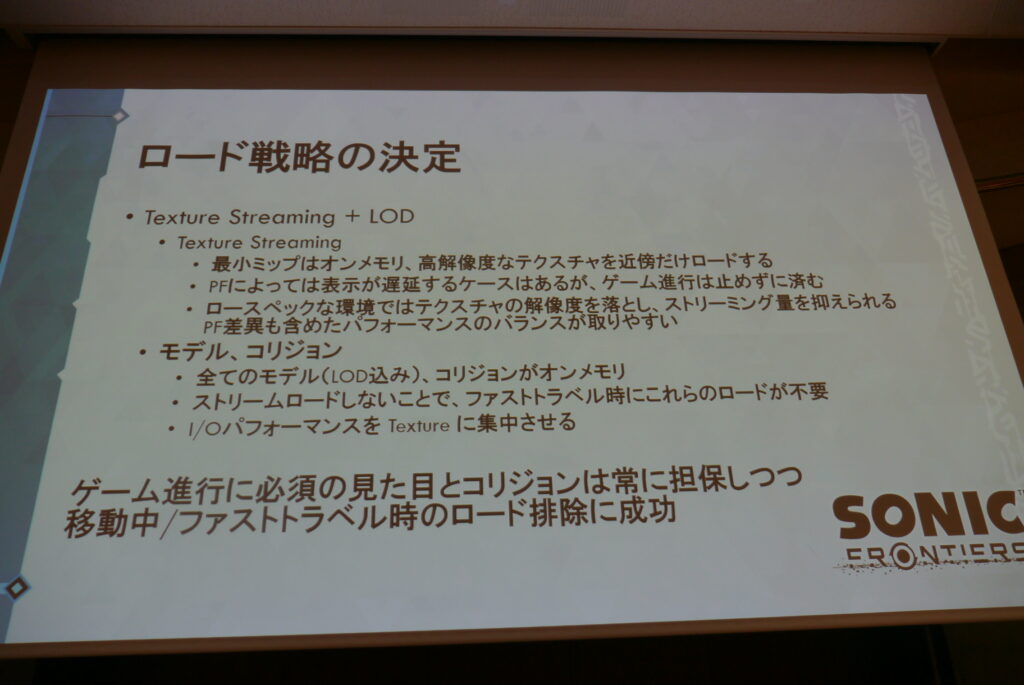
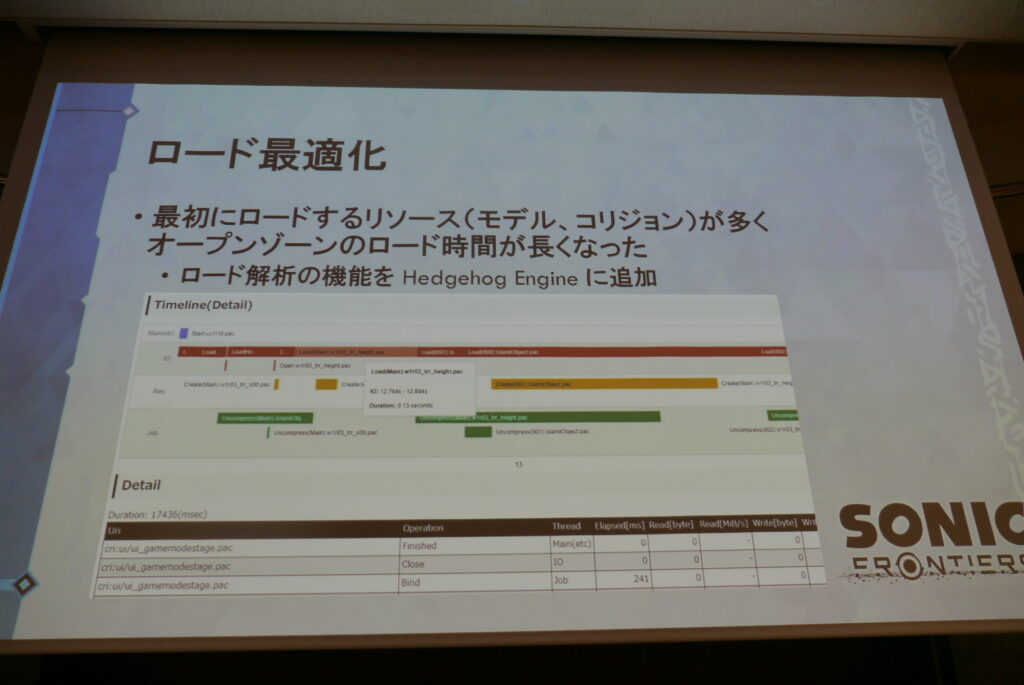
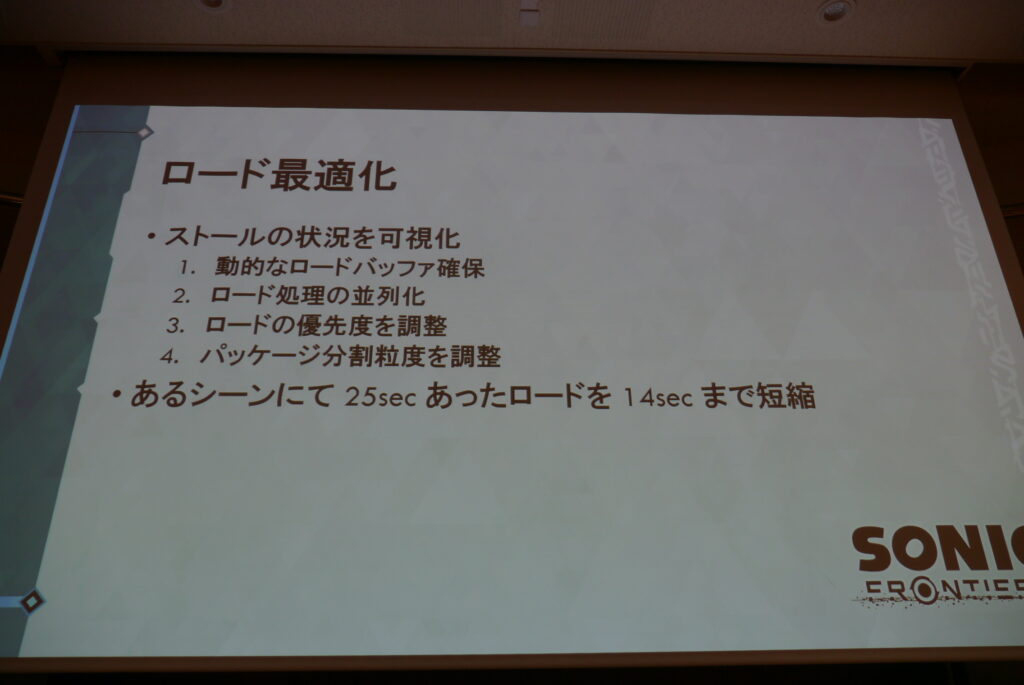
Mr. Tokunaga concluded the lecture by emphasizing the importance of accumulating challenges. It is important to build up step by step and to use common technologies when facing challenges.
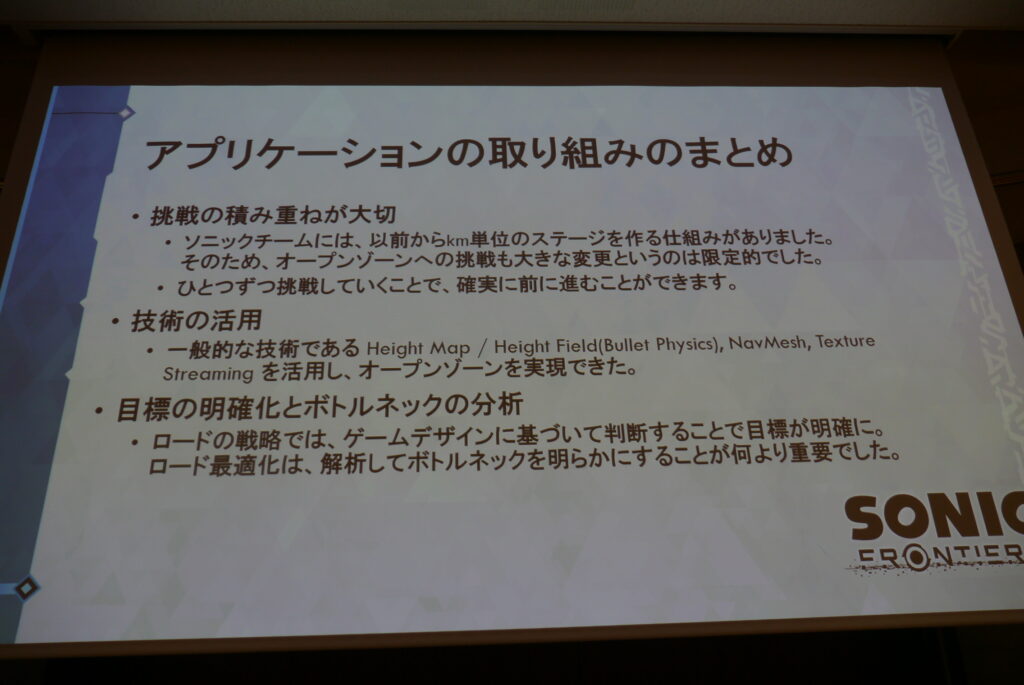
Various tools were used in development, including “Asset Studio” for asset management and conversion, “Needle Viewer,” a plugin that reproduces the same shading and lighting model as in the game on Maya, and “Scene Sync,” which connects Maya and the game via an MCS server. For example, with the course generation tool, selecting a mesh on Maya and creating a course sends it to the game with collisions attached via Scene Sync, allowing for immediate test play. Additionally, the transition to remote work due to the pandemic required further optimization of the development environment.
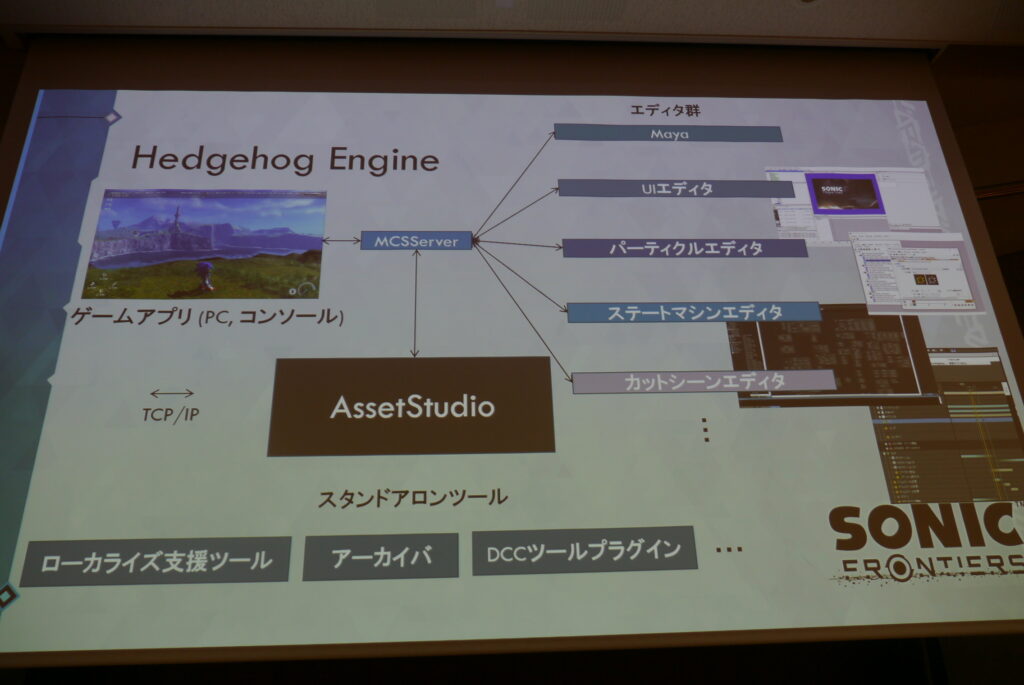
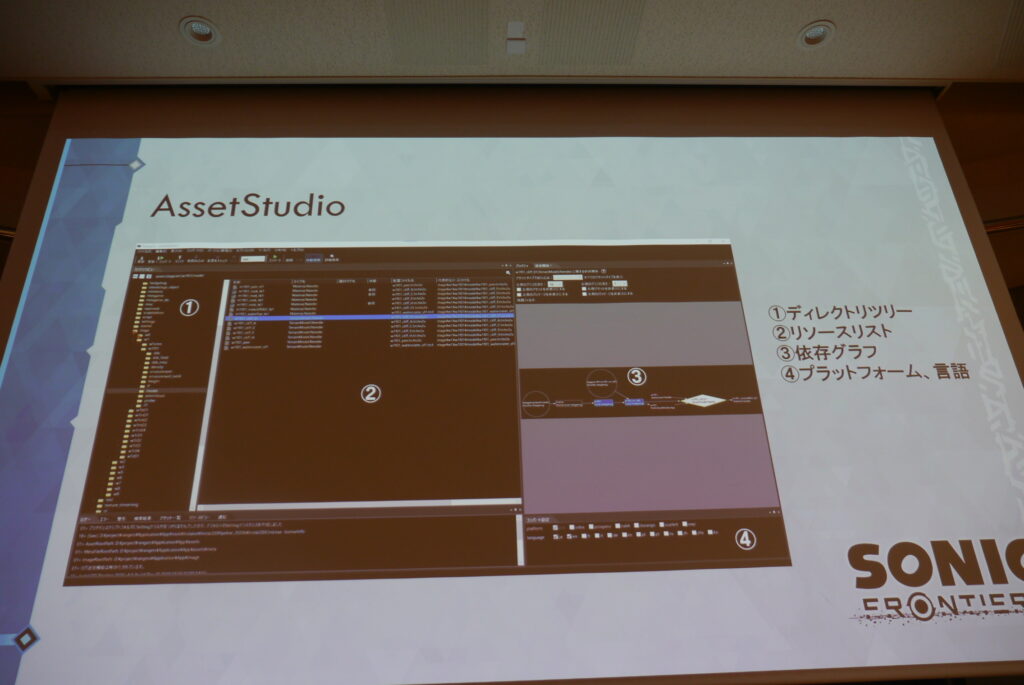
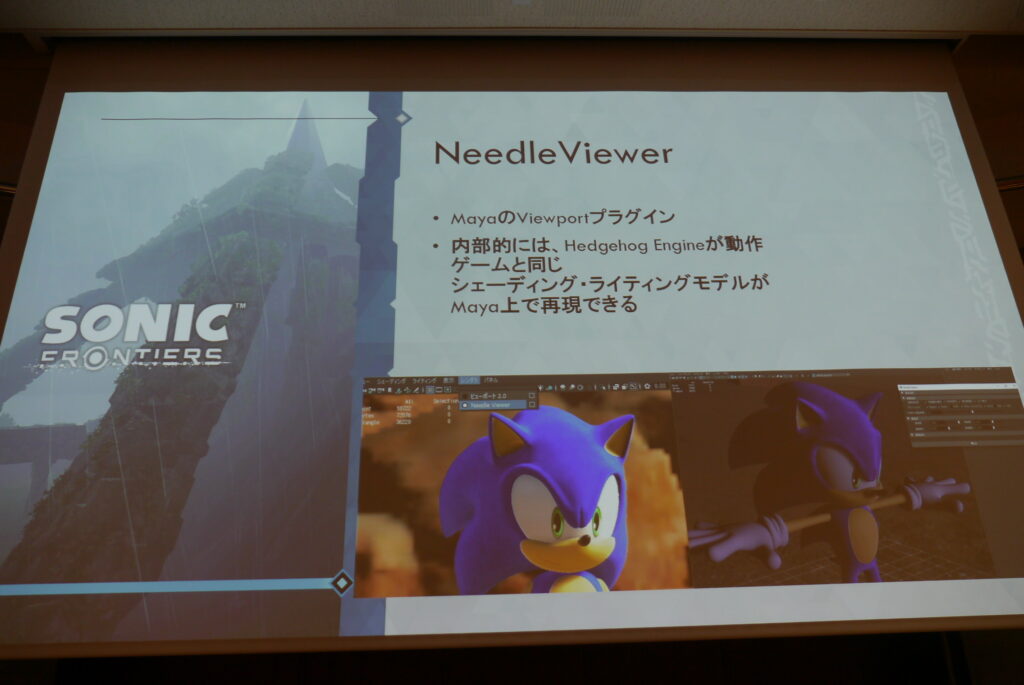
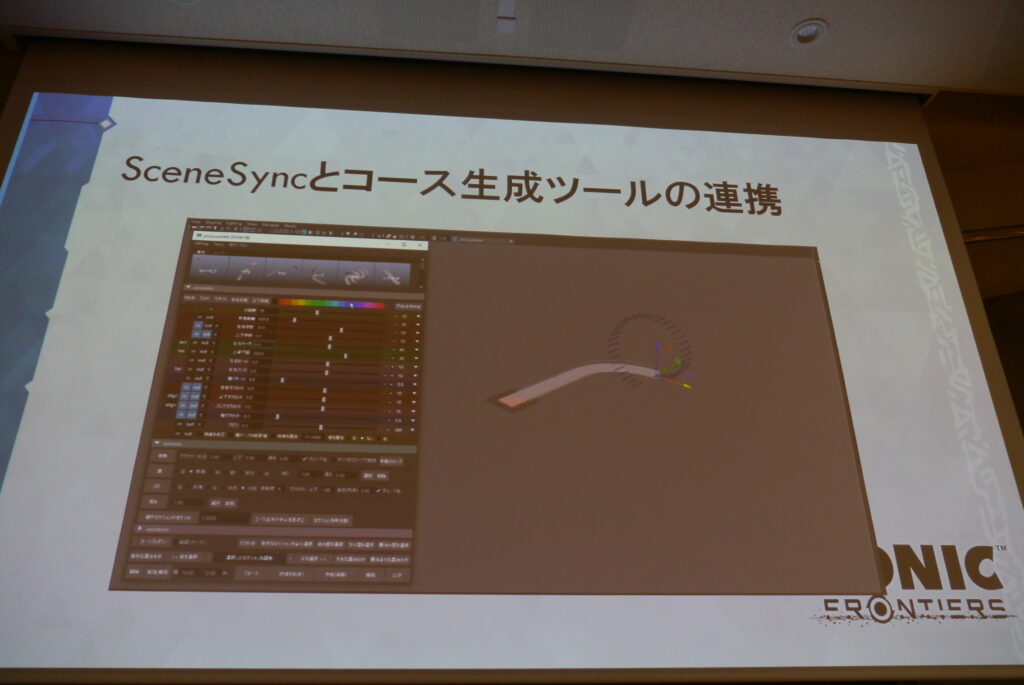
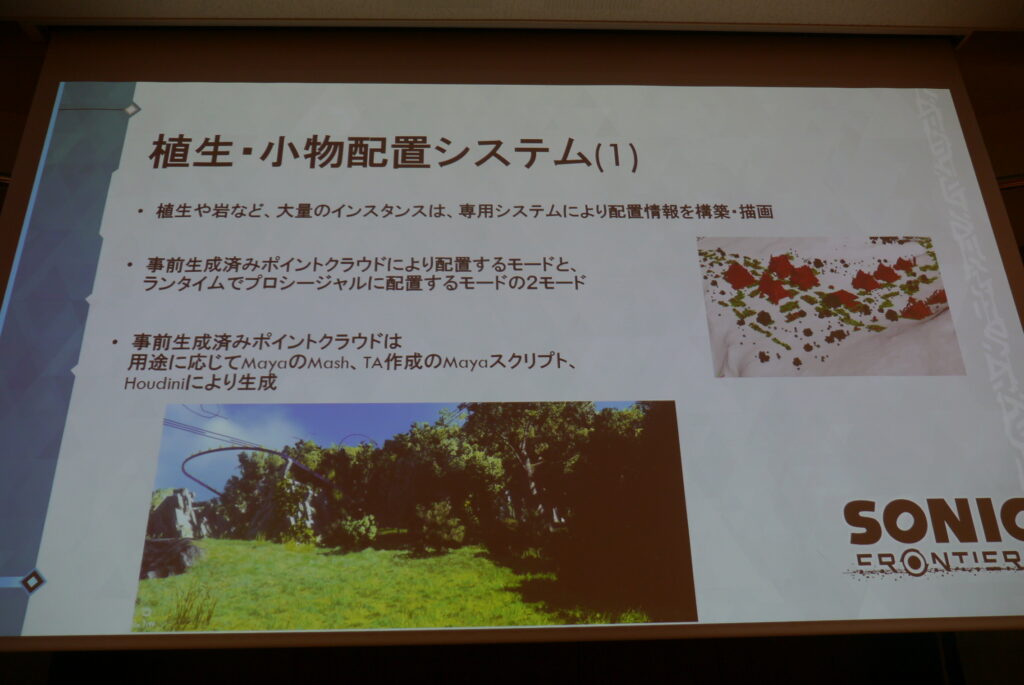
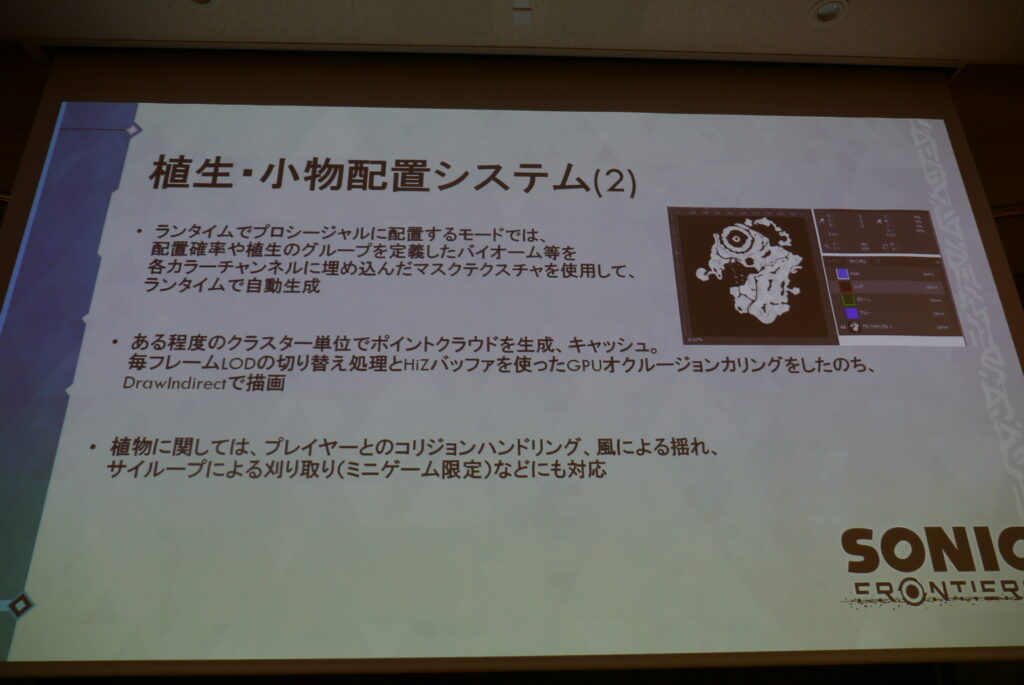
Mr. Inokuma spoke about these initiatives, stating that nothing special was done. The development was reflected upon as a matter of appropriate technology evaluation and selection, automation of simple tasks, profiling to identify bottlenecks, and focused countermeasures.
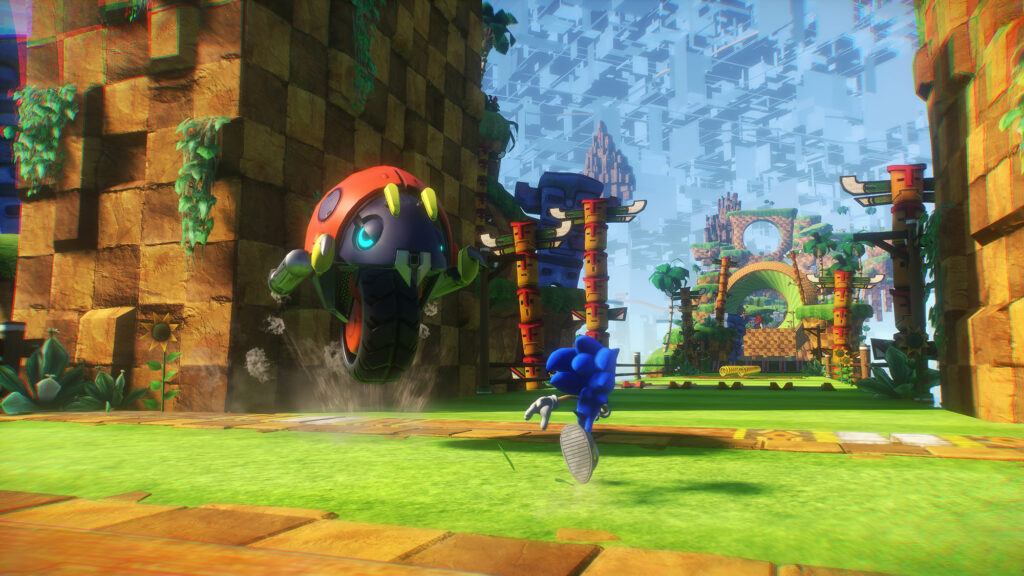
Sonic, with its intense characteristic of speed, required various ingenuities to make the game easy to play while taking on the new challenge of the Open Zone. On September 29, 2023, a free major update (related article) was released, making Amy, Knuckles, and Tails playable in Sonic Frontiers. It might be interesting to play the game again, keeping in mind what was discussed in this lecture.
Source: 4Gamer



